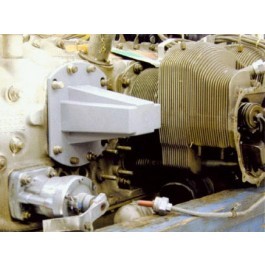It is being done all the time and there are very few issues. Airplanes don’t fall out of sky on a daily basis and he could only show two obscure examples.
I don’t have any issue removing and reinstalling a cylinder, I would do it anytime myself if there is a need. It is a simple job and there isn’t much difficulty in using the proper tool and torquing the nuts according to the manual.
When removing a cylinder, it is important to install back a cover and torque the nuts with the standard torque values as otherwise the through-bolt can get damaged. I would guess that there are shops that don’t know this.
Why the cover?
To prevent dirt from getting inside. The con rod should be wrapped in something soft so it can’t get scratched and then the nuts tightened and a plastic cover on top of the hole. There are special covers made for this purpose.

This isn’t really anything to do with “in the field”? It’s just a matter of whether the job was done properly or not?
Clean the thread? Use a new nut? Use a torque wrench? Torque in correct sequence? That’s pretty basic stuff that should be obvious. The only thing that is “risky” is not bothering to do that stuff properly.
In the two accident examples it seems like the mechanic just didn’t have, or couldn’t be bothered to use, a (calibrated) torque wrench.
And using F900 TorqueSeal so you can visually inspect for any future movement of the nuts would be sensible, and costs 2EUR per tube.
“In the field”, in AE merely means “outside the manufacturer’s factory”, AFAIK. It doesn’t mean “out in the jungle without proper tools and qualified mechanics”.
I absolutely agree that shops tend to pull cylinders without proper justification. For them, it is a very simple and routine task and whenever there is something that needs inspection, they just pull the jug.
When I had dirt in the valve guides, no mechanic in my shop (a very large and good one) believed it was possible to fix it by dropping the valves into the cylinder and fiddling them back with magnets and tools. Their take was even if it was possible, why bother, just pull the cylinder. Back when I needed it, the right tools were not available to pull the cylinder because you need a specially formed wrench to access all nuts and I didn’t feel like building one. So I was lucky because my “jungle” fix was actually the better approach than the standard technique of removing cylinders.
What I don’t agree with is that pulling a cylinder poses a major risk. It’s a routine task and not difficult. Removing an oil filter also has the risk of the new one not being torqued and safety wired properly. The outcome is more catastrophic than an improperly torqued cylinder.
The feeling I get is that there is a bigger risk if you remove the piston.
There is a specific procedure involved in installing the gudgeon pin (wrist pin) and if you bodge it, the plugs will rub against the cylinder wall, hard, and while this rarely just stops the engine, you get lots of aluminium everywhere and eventually that will lead to having to open the engine. A lot of engine shops seem to do this incorrectly.
Safety wiring on an oil filter is pretty easy to visually check, so I would put that in a different category (sheer stupidity).
It depends. On some types you can easily damage the casing if you change s cylinder with the engine installed. Of course for cost reasons everybody does it.
The biggest risk is removing more than one cylinder at a time and worst case scenario is all the cylinders at same time.
The greatest problem is moving the crankshaft with no pre-load on the main bearings (provided by the through bolts) thus allowing a bearing to shift in it’s saddle and cutting off it’s oil supply. This results in a catastrophic failure – guaranteed. .
Could be some idiot moving the airplane whilst all the cylinders are getting overhauled or poor technique when installing the cylinders.
R & R ing cylinders is not rocket science, but nonetheless, most mechanics seem to take a very nonchalant attitude to this high risk maneuver .
Most recent catastrophe I’ve seen: P210 on a flight from Midlands UK to Bordeaux, engine threw a rod, un-eventful dead-stick landing on-airport, luckily.
The engine had a “full top overhaul” just 15 hours before the failure.
Probable cause: Improperly {read NOT] torqued through-bolts.